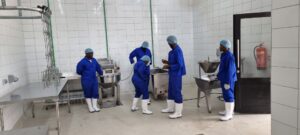
Optimizing Poultry Processing: Equipment and Workflow for Efficiency
Poultry processing is a crucial step in delivering high-quality chicken products to consumers. At Basil’s Business Opportunities, we understand the importance of having an efficient, hygienic, and streamlined operation. In this post, we provide an overview of the essential equipment and workflow required for a poultry processing unit capable of handling 1,000 birds per day.
Poultry Processing Workflow Overview
The poultry processing line follows a structured process to ensure efficiency, hygiene, and compliance with food safety standards. The key stages include:
-
Reception and Stunning: Live birds arrive in heavy-duty poultry crates, each holding 10-12 birds. The birds are stunned using a 12-bird stunner bleeder to ensure humane handling.
-
Scalding and Plucking: Birds are immersed in a 200L scalding tank heated by a 9kW electric element to loosen feathers. A tilting bowl plucker with rubber flails efficiently removes feathers in approximately 35 seconds.
-
Evisceration: Birds are transferred to an evisceration system featuring a 16m conveyor line with 80 shackles. Specialized tools are used to remove internal organs, heads, and necks while maintaining hygiene through an overhead water hose system.
-
Washing and Cooling: Carcasses are thoroughly washed using a high-pressure power washer and hung on drip cooling trolleys capable of holding 108 birds to remove excess water.
-
Portioning and Packaging: Birds can be portioned using an electrically operated poultry cutter. Packaged products are vacuum-sealed using high-shrink plastic film to maintain freshness and prevent dehydration.
-
Cold Storage and Freezing: Processed poultry is stored in a modular cold storage unit (2.5m x 3m) maintained at 2°C. A separate walk-in freezer (3m x 4m) preserves up to 450kg of poultry at -20°C.
Essential Equipment for Poultry Processing
A poultry processing unit handling 1,000 birds per day requires specialized equipment to maintain efficiency and hygiene. Key equipment includes:
-
Live Bird Crates: Heavy-duty plastic crates for safe bird transport.
-
Stunner Bleeder: Ensures humane stunning of up to 12 birds at a time.
-
Scalding Tank: A 200L capacity tank with a thermometer to control scalding temperatures.
-
Plucking Machine: Tilting bowl design for fast feather removal.
-
Evisceration System: Includes a conveyor line with 80 shackles and specialized evisceration tools.
-
Cooling Trolleys: Designed to hold 108 birds for effective water drainage.
-
Poultry Portion Cutter: For precise cutting of poultry into portions.
-
Cold and Freezer Storage: Modular units for preserving product quality at appropriate temperatures.
-
Sanitation Equipment: Boot wash, hand wash basins, and sterilizers to maintain hygiene standards.
Staffing Requirements
Operating a poultry processing unit requires a dedicated team to handle each stage of the workflow. For a 1,000 bird/day capacity, the following staff roles are recommended:
-
1 Receptionist/Sticker
-
1 Scalder Operator
-
1 Plucker Operator
-
2 Eviscerators
-
2 Packers/Trussers
-
1 Manager/Dispatcher
-
1 Cleaner/Labourer
-
1 Launderer
Why an Efficient Poultry Processing Line Matters
A well-structured poultry processing line ensures:
-
Improved Efficiency: Faster processing times reduce bottlenecks and increase output.
-
Better Hygiene: Clear separation of clean and dirty areas ensures food safety compliance.
-
Product Quality: Proper handling, cooling, and packaging preserve product freshness.
-
Scalability: A robust system allows for future expansion as business demands grow.
At Basil’s Business Opportunities, we provide turnkey solutions for poultry processing, including equipment supply, installation, and training. If you’re looking to establish or upgrade your poultry processing facility, we are here to support you every step of the way.
Contact us today to learn more about optimizing your poultry processing operations.